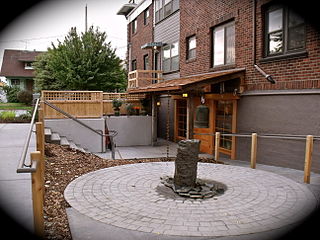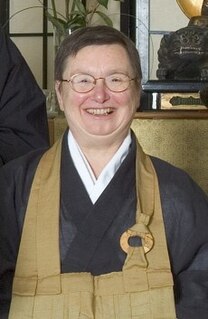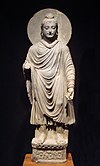Sōtō Zen or the Sōtō school is the largest of the three traditional sects of Zen in Japanese Buddhism. It is the Japanese line of the Chinese Cáodòng school, which was founded during the Tang dynasty by Dòngshān Liánjiè. It emphasizes Shikantaza, meditation with no objects, anchors, or content. The meditator strives to be aware of the stream of thoughts, allowing them to arise and pass away without interference.

Shunryu Suzuki was a Sōtō Zen monk and teacher who helped popularize Zen Buddhism in the United States, and is renowned for founding the first Buddhist monastery outside Asia. Suzuki founded San Francisco Zen Center which, along with its affiliate temples, comprises one of the most influential Zen organizations in the United States. A book of his teachings, Zen Mind, Beginner's Mind, is one of the most popular books on Zen and Buddhism in the West.
Buddhism in the West broadly encompasses the knowledge and practice of Buddhism outside of Asia in the Western world. Occasional intersections between Western civilization and the Buddhist world have been occurring for thousands of years. The first Westerners to become Buddhists were Greeks who settled in Bactria and India during the Hellenistic period. They became influential figures during the reigns of the Indo-Greek kings, whose patronage of Buddhism led to the emergence of Greco-Buddhism and Greco-Buddhist art. There was little contact between the Western and Buddhist cultures during most of the Middle Ages but the early modern rise of global trade and mercantilism, improved navigation technology and the European colonization of Asian Buddhist countries led to increased knowledge of Buddhism among Westerners. This increased contact led to various responses from Buddhists and Westerners throughout the modern era. These include religious proselytism, religious polemics and debates, Buddhist modernism, Western convert Buddhists and the rise of Buddhist studies in Western academia. During the 20th century there was a growth in Western Buddhism due to various factors such as immigration, globalization, the decline of Christianity and increased interest among Westerners. The various schools of Buddhism are now established in all major Western countries making up a small minority in the United States, Europe, Australia and New Zealand.
Engaged Buddhism refers to Buddhists who are seeking ways to apply the insights from meditation practice and dharma teachings to situations of social, political, environmental and economic suffering and injustice. Finding its roots in Vietnam through the Zen Buddhist teacher Thích Nhất Hạnh, Engaged Buddhism has grown in popularity in the West.

Robert Baker Dairyu Chotan Aitken Rōshi was a Zen teacher in the Harada-Yasutani lineage. He co-founded the Honolulu Diamond Sangha in 1959 together with his wife, Anne Hopkins Aitken. Aitken received Dharma transmission from Koun Yamada in 1985 but decided to live as a layperson. He was a socialist advocating social justice for gays, women and Native Hawaiians throughout his life, and was one of the original founders of the Buddhist Peace Fellowship.
Buddhism is a legally recognized religion in Austria. Although still small in absolute numbers, Buddhism in Austria enjoys widespread acceptance. A majority of Buddhists in the country are Austrian nationals, while a considerable number of them are foreign nationals.

Buddhism, once thought of as a mysterious religion from the East, has now become very popular in the West, including the United States. As Buddhism does not require any formal "conversion", American Buddhists can easily incorporate dharma practice into their normal routines and traditions. The result is that American Buddhists come from every ethnicity, nationality and religious tradition. In 2012, U-T San Diego estimated U.S. practitioners at 1.2 million people, of whom 40% are living in Southern California. In terms of percentage, Hawaii has the most Buddhists at 8% of the population due to its large Asian American community.

With nearly 250,000 Buddhists, Brazil is home to the third largest Buddhist population in the Americas, after the United States and Canada. Buddhism in Brazil consists of practitioners from various Buddhist traditions and schools. A number of Buddhist organisations and groups are also active in Brazil, with nearly 150 temples spread across the states.

Sanbo Kyodan is a lay Zen sect derived from both the Soto (Caodong) and the Rinzai (Linji) traditions. It was renamed Sanbo-Zen International in 2014. The term Sanbo Kyodan has often been used to refer to the Harada-Yasutani zen lineage. However, a number of Yasutani’s students have started their own teaching lines that are independent from Sanbo Kyodan. Strictly speaking, Sanbo Kyodan refers only to the organization that is now known as Sanbo-Zen International.

Taisen Deshimaru was a Japanese Sōtō Zen Buddhist teacher, who founded the Association Zen Internationale.

Hakuyū Taizan Maezumi was a Japanese Zen Buddhist teacher and rōshi, and lineage holder in the Sōtō, Rinzai, and Sanbo Kyodan traditions of Zen. He combined the Rinzai use of kōans and the Sōtō emphasis on shikantaza in his teachings, influenced by his years studying under Hakuun Yasutani in Sanbo Kyodan. He founded or co-founded several institutions and practice centers, including the Zen Center of Los Angeles, White Plum Asanga, Yokoji Zen Mountain Center and the Zen Mountain Monastery.
The Soto Zen Buddhist Association was formed in 1996 by American and Japanese Zen teachers in response to a perceived need to draw the various autonomous lineages of the North American Sōtō stream of Zen together for mutual support as well as the development of common training and ethical standards. With about one hundred fully transmitted priests, the SZBA now includes members from most of the Japanese-derived Sōtō Zen lineages in North America. The founding president was Tetsugen Bernard Glassman, followed by Sojun Mel Weitsman, Myogen Steve Stucky, Jishō Warner, and Eido Frances Carney.

Dai Bai Zan Cho Bo Zen Ji is a Rinzai-style Zen temple, located on North Beacon Hill in Seattle, Washington. Its name translates from Japanese as "Listening to the Dharma Zen Temple on Great Plum Mountain."
Zen is the Japanese variant of Chan Buddhism, a Mahayana school that strongly emphasizes dhyana, the meditative training of awareness and equanimity. This practice, according to Zen proponents, gives insight into one's true nature, or the emptiness of inherent existence, which opens the way to a liberated way of living.
Ryōmō Kyōkai (両忘協会 "Ryōmō Society", was a lay Rinzai Zen Buddhist practice center located in Tokyo, Japan.

Toni Packer was a teacher of "meditative inquiry", and the founder of Springwater Center. Packer was a former student in the Sanbo Kyodan lineage of Zen Buddhism, and was previously in line to be the successor of Phillip Kapleau at the Rochester Zen Center.
Zen master is a somewhat vague English term that arose in the first half of the 20th century, sometimes used to refer to an individual who teaches Zen Buddhist meditation and practices, usually implying longtime study and subsequent authorization to teach and transmit the tradition themselves.

Gyokuko Carlson is a Soto Zen roshi and abbess of Dharma Rain Zen Center in Portland, Oregon, United States. She was formerly the co-abbot along with her husband, the late Kyogen Carlson. Carlson and her husband practiced at Shasta Abbey when Jiyu Kennett was the abbess, leaving to found their own center in 1986 when celibacy became a requirement at Shasta Abbey. She has been a practitioner of Zen Buddhism for more than thirty years, and is a member of the American Zen Teachers Association.
The Zen Peacemakers is a diverse network of socially engaged Buddhists, currently including the formal structures of the Zen Peacemakers International, the Zen Peacemaker Order and the Zen Peacemaker Circles, many affiliated individuals and groups, and communities formed by Dharma Successors of Roshi Bernie Glassman. It was founded by Bernie Glassman and his wife Sandra Jishu Holmes in 1996, as a means of continuing the work begun with the Greyston Foundation in 1980 of expanding Zen practice into larger spheres of influence such as social services, business and ecology but with a greater emphasis on peace work. Zen Peacemakers has developed from the White Plum Asanga lineage of Taizan Maezumi.
Zen was introduced in the United States at the end of the 19th century by Japanese teachers who went to America to serve groups of Japanese immigrants and become acquainted with the American culture. After World War II, interest from non-Asian Americans grew rapidly. This resulted in the commencement of an indigenous American Zen tradition which also influences the larger western (Zen) world.











